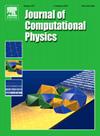An accurate immersed boundary method using radial-basis functions for incompressible flows
IF 3.8
2区 物理与天体物理
Q2 COMPUTER SCIENCE, INTERDISCIPLINARY APPLICATIONS
引用次数: 0
Abstract
In this work, we introduce a parallel computational solver based on the sharp-interface immersed boundary method for simulating three-dimensional incompressible flows over stationary and moving boundaries. Despite the robustness and ease of implementation of conventional body-conformal grid methods, they are limited to relatively simple immersed geometries, leading to challenges in grid generation and quality. Our approach employs a multi-dimensional ghost-cell methodology and radial basis functions interpolation/splines to achieve accurate boundary condition and superior efficiency. We utilize unstructured triangular elements for geometric surface discretization and non-uniform Cartesian grids for constructing flow domains around the immersed boundaries. Furthermore, full parallelization using domain decomposition ensures scalability on distributed memory platforms, facilitated through message-passing interface libraries. Additionally, we introduce a flow smoothing strategy to mitigate spurious pressure oscillations near immersed bodies. Through simulations of two- and three-dimensional fluid-structure interaction problems, we demonstrate the effectiveness, accuracy, and efficiency of our computational solver.
基于径向基函数的不可压缩流精确浸入边界法
在这项工作中,我们介绍了一个基于锐界面浸入边界法的并行计算求解器,用于模拟固定边界和移动边界上的三维不可压缩流动。尽管传统的体保形网格方法具有鲁棒性和易于实现性,但它们仅限于相对简单的浸入几何形状,导致网格生成和质量方面的挑战。我们的方法采用了多维鬼胞方法和径向基函数插值/样条,以获得精确的边界条件和优越的效率。我们利用非结构化三角形单元进行几何表面离散化,并利用非均匀笛卡尔网格来构建浸入边界周围的流域。此外,通过消息传递接口库,使用领域分解的完全并行化确保了分布式内存平台上的可伸缩性。此外,我们还引入了一种流动平滑策略来减轻沉体附近的伪压力振荡。通过对二维和三维流固耦合问题的模拟,我们证明了计算求解器的有效性、准确性和高效性。
本文章由计算机程序翻译,如有差异,请以英文原文为准。
求助全文
约1分钟内获得全文
求助全文
来源期刊

Journal of Computational Physics
物理-计算机:跨学科应用
CiteScore
7.60
自引率
14.60%
发文量
763
审稿时长
5.8 months
期刊介绍:
Journal of Computational Physics thoroughly treats the computational aspects of physical problems, presenting techniques for the numerical solution of mathematical equations arising in all areas of physics. The journal seeks to emphasize methods that cross disciplinary boundaries.
The Journal of Computational Physics also publishes short notes of 4 pages or less (including figures, tables, and references but excluding title pages). Letters to the Editor commenting on articles already published in this Journal will also be considered. Neither notes nor letters should have an abstract.
 求助内容:
求助内容: 应助结果提醒方式:
应助结果提醒方式:


